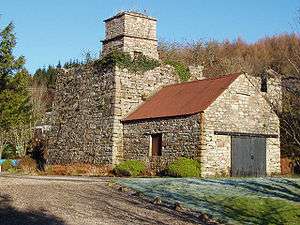Furnace, Argyll

Furnace (Scottish Gaelic: An Fhùirneis) (formerly Inverleacainn (Scottish Gaelic: Inbhir Leacainn)) is a village in Argyll, on the west coast of Scotland, on the north shore of Loch Fyne, the longest sea loch in the United Kingdom. Furnace is around eight miles southwest of Inveraray on the A83 road.
It is unusual for a West Highland village in having an industrial past in addition to the usual focus on agriculture and fishing. Industrial activity was led by three main businesses: the iron furnace, the powdermills and the quarry.
Iron furnace
This was the first to arrive, built in 1755[1] by the Duddon Company of Cumbria, drawn by the local forest capable of supplying the charcoal needed in smelting iron. The village, then called Inverleacainn (the mouth of the River Leacainn) gradually took on the shorthand name of ‘the furnace’ and finally, simply ‘Furnace’. The furnace itself shut down in 1813, made redundant by the coal-fired steam engine.[2] The Duddon Company was bought by Harrison Ainslie in 1828.
Loch Fyne Powderworks
The same charcoal resource that fed the furnace supported the development of the next industry to arrive - the manufacture of gunpowder using charcoal, sulphur and saltpetre. The Loch Fyne Powderworks, one of four in Argyll, was built in 1841 and was criticised for its safety standards after the Explosives Act 1875. The company had sited an 80-ton storage magazine 80 metres from the village school. 1883 saw the end of ‘The Powdermills’ when it blew up with a stove-house explosion. The only casualty was the manager, William Robinson, who was not even on site at the time but at home for lunch 230 metres away and killed by flying rocks. The explosion was the subject of a Government enquiry, with concerns (which were never substantiated) about industrial sabotage by rival firms.
Quarry
The third industry was the quarry, opening in 1841 during the term of the Powdermills and still in operation today. It supplied cobbles for the streets of Glasgow and was the biggest employer in the area. Over 200 men then cut the pink granite by hand. The quarry, which now produces crushed stone and concrete in volume, is now fully mechanised, and employs 3-4 men.
Furnace and the Camanachd Cup
In the national sport of shinty, Furnace holds a record that cannot be beaten and was not equalled until 2013. In 1923, the Furnace team won the premier national competition, the Camanachd Cup, beating Newtonmore 2-0 at Inverness – and without having dropped a single goal from the start of the competition to their ultimate victory.[3] Newtonmore equalled this feat in 2013 when they won the Camanachd Cup without conceding a goal.
Notable residents
The Gaelic poet Evan McColl was born in 1808 at Kenmore, a township on the northern fringe of Furnace. McColl, who wrote "The Mountain Minstrel" (Gaelic "Clarsach nam Beann), died at the end of the 19th Century. A stone cairn was erected in his memory at Kenmore, on the rocks above the loch and was unveiled in 1930 by the Duke of Argyll.
Former residents of Furnace include the late Duncan Williamson, a celebrated traditional storyteller, author of The Horsieman and a member of Scotland's gypsy travellers, not recognised as a distinct ethnic group. Williamson's first wife was his cousin, Jeannie Townsley with whom he had ten children. There are still members of the Townsley family living in Furnace. An American academic, now Dr Linda Williamson, became his second wife and guided his career as a celebrated and published storyteller. They had two children.
The Tower of London’s first female Beefeater, Moira Cameron, appointed in 2007, is from Furnace, living above the village at Goatfield.
Furnace today
Furnace and its population today are very different from what they were in its industrial heyday. From a village with 200 working stone-cutters alone, Furnace in 2008 has a total population of little over 200, many retired or semi-retired. A significant source of work is fish farming, but this employs fewer people than locals had initially hoped.
The village primary school, which had a roll of 40 in the 1930s, now has 24 pupils. Of seven local shops a single one remains, along with The Furnace Inn and a post office. The village has a health centre and a visiting dentist, a sports pitch, and a children’s play park.
The Leacainn Walk, a 6-mile circular walk from the village following some of the old drover’s roads, crosses the River Leacainn and passes many local landmarks. The villagers created the walk as a millennium project.
References
- ↑ Historic Scotland, recording that the lintel is marked GF 1755.
- ↑ Harrison Ainslie
- ↑ Shinty history in the making - Herald Scotland | Sport | SPL | Aberdeen
| Wikimedia Commons has media related to Furnace, Argyll and Bute. |
Coordinates: 56°09′06″N 5°10′53″W / 56.15166°N 5.18127°W